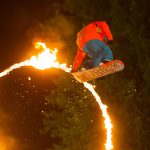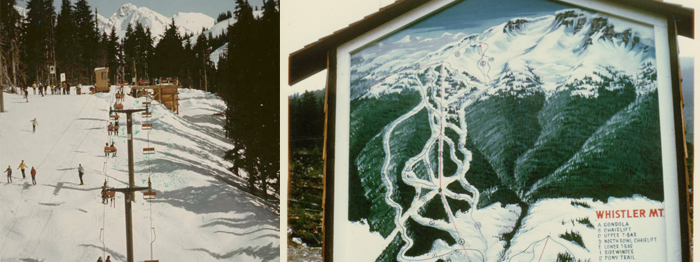
HISTORICAL PHOTOS COURTESY WHISTLER MUSEUM & ARCHIVES
Guest Author: Sarah Drewery
Editors Note: Whistler’s excellent Pique Newsmagazine ran a version of this story in December 2014 but The Insider wanted to ensure our global audience also has a chance to learn some of this awesome Whistler history.
For many of us who ski in Whistler — from first time visitors to long-term locals — it’s natural to be curious about the plethora of weird, wonderful and intriguing run names found on both mountains. Some, like “Burnt Stew” or “Pig Alley” seem inexplicable, others like “VD Chutes” just seem alarming.
When you scratch beneath the surface, however, the names of Whistler’s ski runs reflect our rich history and culture, telling stories from the pioneer times to the present day. Thankfully, the Whistler Museum has been carefully recording some of the stories behind the runs and here are a few of our favourites. We’ll do Whistler Mountain this week and jump over to Blackcomb next week. Enjoy.
Whistler Mountain Ski Run Names
Pony Trail
The oldest run on Whistler Mountain. When the ski hill was being built in the summer of 1965, workers would take materials and supplies up the mountains by packhorse. The pony trail was the route cut for the horses to use. Because it took the easiest route possible, it was the perfect candidate to become Whistler’s first green run.
McConkey’s
Named after Jim McConkey, the ski school star of early Whistler Mountain.
With a magnetic personality and an already distinguished ski career south of the border, “Diamond Jim” moved to Whistler in the spring of 1968 and invested all his money building a ski shop here. The risk proved wise as new equipment and technology drew more people to the sport which, consequently, created a greater market for instructing and gear. Jim managed the ski school until 1980 and the rental and retail operations until 1985.
Whistler Mountain honoured Jim by naming a run after him on Dec. 15, 1994 — the same day that the Harmony Express chairlift was opened. A true fun-lover with an infectious joy for mountain life — McConkey’s catchphrase “Every day’s a bonus” is one we can all learn from.

LEFT: Jim McConkey. RIGHT: Franz Whilhelmsen at the opening/renaming of Franz’ Run, 1983.
Franz’ Run
Already a successful Vancouver business man Franz Wilhelmsen was one of the founders of Whistler Mountain and President of the company for its first 23 years. Franz’ vision and drive were integral to making the dream of a ski hill on Whistler Mountain a reality. In 1983, Whistler Mountain honoured its father by naming his favourite ski run, a steep west-facing classic, “Franz’ Run”. A chairlift was also named after him in 1998.
Chunky’s Choice
Named after Chunky Woodward, one of the founding directors of Garibaldi Lifts Ltd. and the head of Woodward’s Department Store. It was his favourite run.
Jimmy’s Joker
Named after one of the loggers who felled trees on Whistler Mountain to create ski runs. One particularly foggy and cloudy afternoon in the summer of 1966 Jimmy was meant to be cutting down trees to create what is now known as “Franz’ Run” but he got disoriented in the weather. By the time Jimmy realized he was lost, he had cut enough trees to make a new ski run and his mistake became a great joke among the other loggers. The run was consequently called “Jimmy’s Joker.”
Burnt Stew
In the summer of 1958, before Whistler Mountain became a ski hill, Florence Petersen, Kelly Fairhurst and Don Gow were on a backpacking trip around the Mountain. After setting up camp one evening they started cooking dinner in an old billy can over a fire, built into the rocks of a dry creek bed. Nobody remembered to stir the pot, resulting in the smell after which the area is named.
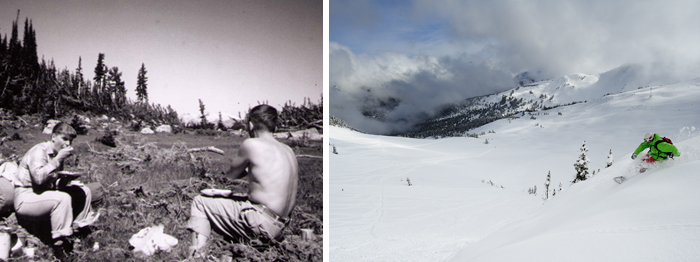
LEFT: Florence Peterson and Don Gow eating some “burnt stew” on their 1958 hike. RIGHT: Burnt Stew Basin full of snow.
Ego Bowl
Named for the inflated egos of those skiers who’s showboating could be easily admired by onlookers from the Green Chair above.
Pig Alley
A short cut from Whiskey Jack to Ego Bowl, was the nickname of the ski patrol’s first skidoo, a pig of a machine that always got stuck. The patrol had the trail cut because it was easier to cross over to Ego Bowl and climb that with the skidoo than to climb Whiskey Jack.
Tokum
Named after Tokum Corners – a “ski bum’ house lived in by John Hetherington, George Benjamin and a number of others. It was named by Rod MacLeod and Bruce Prentice who laid out the run, and who had both lived in Tokum Corners.
Seppo’s Run
Seppo Makinen logged many of the early runs on both Whistler and Blackcomb. He was an unstoppable workhorse with incredible strength of body and character. In 1980 Seppo cut his last run and the wild, off-camber descent quickly became a local’s favourite on big snow days. It was named “Seppo’s” in his honour.
Whenever nostalgia causes long-time Whistler locals to reminisce about the old days, the conversation invariably leads to Seppo, who’s door was always open to those with nowhere else to stay. It says a lot about this community that one of the most cherished figures in our history was not a politician or “founder” in the traditional sense, but a generous and warm-hearted Finnish logger.
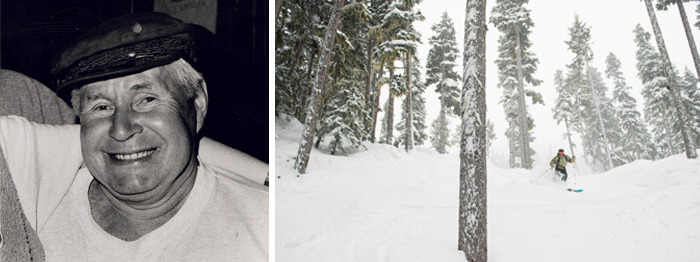
LEFT: Whistler legend Seppo Makinen. RIGHT: Trees near Seppo’s run on Whistler Mountain.
VD Chutes
Despite what you might imagine this actually stands for Very Difficult
The Saddle
Is named for the saddle shape at the entrance to the run. Prior to the construction of the Peak Chair this area was a cliff. Later it was blasted out and bulldozed to create the run.
Dave Murray Downhill
Dave Murray is one of Whistler’s greatest skiing legends. Born and raised in Vancouver, his family owned a cabin on Alpha Lake so Whistler was literally a second home. Dave’s skiing earned him a spot on the legendary Crazy Canucks, a team of Canadian downhill racers in the late 1970s and early 1980s known for their fearless racing style. Fellow Crazy Canuck, Steve Podborski remembers, “Dave was a much more complex man than just a ski racer. He was a deep thinker who realized skiing was just for the moment. He was a powerful influence on all of us. He gave us a balance and perspective we wouldn’t have had without him. He was a creator.”
Murray retired from competitive skiing following the 1982 season and returned to Whistler to found the Dave Murray Ski School. He passed away in 1989 and the Downhill course was named in his honour in 1990. The run is considered one of the best in the world and in 2010 the Dave Murray Downhill was used in the 2010 Winter Games.
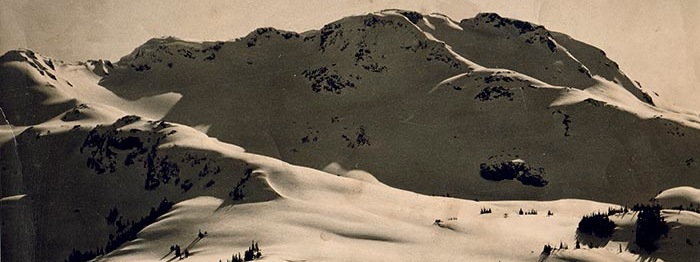
The Saddle, before the entrance was blasted sits in the upper left of this photo from 1964.
That’s it for Whistler Mountain, learn about the runs on Blackcomb Mountain next week and in the meantime you can find trail maps, accommodation deals and everything else you need at Whistler.com

